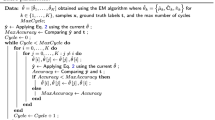Abstract
In this paper, we present a thorough mathematical analysis of the use of neural networks to solve a specific classification problem consisting of a bilinear boundary. The network under consideration is a three-layered perceptron with two hidden neurons having the sigmoid serving as the activation function. The analysis of the hidden space created by the outputs of the hidden neurons will provide results on the network’s capacity to isolate two classes of data in a bilinear fashion, and the importance of the value of the sigmoid parameter is highlighted. We will obtain an explicit analytical function describing the boundary generated by the network, thus providing information on the effect each parameter has on the network’s behavior. Generalizations of the results are obtained with additional neurons, and a theorem concerned with analytical reproducibility of the boundary function is established.






















Similar content being viewed by others
Explore related subjects
Discover the latest articles and news from researchers in related subjects, suggested using machine learning.References
Rumelhart DE, Hinton GE, Williams RJ (1986) “Learning internal representations by error propagation”, parallel distributed processing. Explor Microstruct Cogn 1:318–362
Widrow B, Hoff ME (1988) Adaptive switching circuits. IRE WESCON Conv Rec 4:96–104
Hornik K, Stinchcombe M, White H (1989) Multilayer feedforward networks are universal approximators. Neural Netw 2:359–366. doi:10.1016/0893-6080(89)90020-8
Funahashi K (1989) On the approximate realization of continuous mappings by neural networks. Neural Netw 2:183–192. doi:10.1016/0893-6080(89)90003-8
Hecht-Nielsen R (1989) Theory of the back-propagation neural network. Proc Int Jt Conf Neural Netw 1:593–605. doi:10.1109/IJCNN.1989.118638
Lee C, Jung E (2000) Dimension expansion of neural networks. IEEE Geosci Remote Sens Symp 2:678–680
Lee C, Kwon O (2001) “Edge representation and recognition using neural networks”, industrial electronics. Proc Int Symp Neural Netw 1:110–113
Ratle F, Lecarpentier B, Labib R, Trochu F (2004) Multi-objective optimization of a composite material spring design using an evolutionary algorithm. In: Proceedings of the 8th international conference on parallel problem solving from nature, pp 803–811
Lee C, Kwon O, Jung E (2001) Geometry of decision boundaries of neural networks. SPIE Proc Ser 4471:167–179
Bishop CM (1995) Neural networks for pattern recognition. Clarendon Press, Oxford, p 482
Author information
Authors and Affiliations
Corresponding author
Rights and permissions
About this article
Cite this article
Labib, R., Khattar, K. MLP bilinear separation. Neural Comput & Applic 19, 305–315 (2010). https://doi.org/10.1007/s00521-009-0309-4
Received:
Accepted:
Published:
Issue Date:
DOI: https://doi.org/10.1007/s00521-009-0309-4




